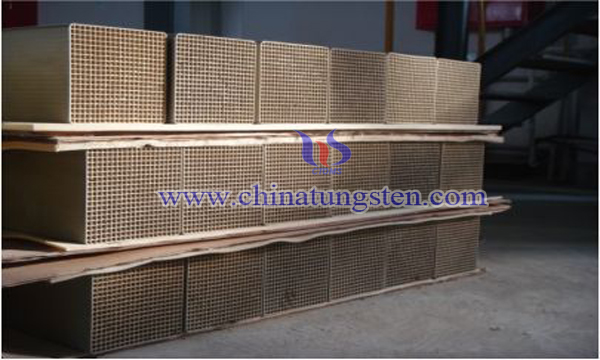SCR Spent Catalyst Recycle
- Details
- Category: Tungsten Information
- Published on Thursday, 06 September 2018 22:40
Nitrogen oxide (NOx) is one of the sources of air pollution and poses a great threat to human health. Thermal power plant is one of the main sources of NO_x emission. At present, the main dry flue gas denitrification method is selective catalytic reduction (SCR), the key part of which is catalyst.

SCR catalyst usually takes TiO2 as the carrier, and rare metal oxides such as WO3 and V2O5 as active components. Among them, WO3 content is about 2-10%, V2O5 content is more than 0.5%, TiO2 content is more than 70%, WO3, V2O5 and the total content of TiO2 is often more than 90%. Generally speaking, the catalyst is valid for three years, the catalyst returned contains a large number of metal elements, improper treatment will cause serious environmental pollution, and titanium metal. Tungsten and vanadium are valuable metals in price quotas and have the necessity of recycling.
At present, the recovery of SCR waste catalyst is carried out in the following ways:
A. Pretreatment: cleaning, drying, crushing and grinding SCR waste catalyst to particle size less than 150 m;
B.Soda sintering: the SCR waste catalyst powder obtained in step a was mixed with sodium carbonate and sintered at high temperature to obtain sintering materials.
C.Leaching: adding water to the sintering material obtained by step B for heating stirring to leach tungsten and vanadium, the leaching solution obtained by solid-liquid separation is sodium salt solution containing tungsten and vanadium, and the leaching slag is titanium-rich material.
D. Extraction of tungsten: the leaching solution obtained from step C is adjusted to pH above 12, and the leaching solution is contacted with the organic phase for multi-stage extraction of tungsten. Tungsten is put into the organic phase, and vanadium and impurities such as phosphorus, arsenic and silicon are left in the residual liquid after extraction of tungsten, that is, the negative tungsten organic phase and the residual liquid after extraction of tungsten are obtained.
E.Extraction of vanadium: adjust the pH of the residual liquid from step d to 9.5-11.5, contact the solution with the organic phase for multi-stage extraction of vanadium, vanadium into the organic phase, impurities such as phosphorus, arsenic, silicon remain in the residual liquid after extraction of vanadium, that is, negative vanadium organic phase and the residual liquid after extraction of vanadium.
Through the above process, SCR waste catalyst can separate tungsten, vanadium and titanium from impurity phosphorus, arsenic and silicon, recover and enrich vanadium, titanium and tungsten, and put them into the field of environmental protection application again, which not only brings the benefits of resources into play, but also saves the cost of environmental protection.
- Tungsten Oxide Manufacturer & Supplier, Chinatungsten Online: www.tungsten-oxide.com
- Tungsten News & Prices of China Tungsten Industry Association: www.ctia.com.cn
- Molybdenum News & Price: news.molybdenum.com.cn
- Tel.: 86 592 5129696; Fax: 86 592 5129797; Email: sales@chinatungsten.com



 sales@chinatungsten.com
sales@chinatungsten.com